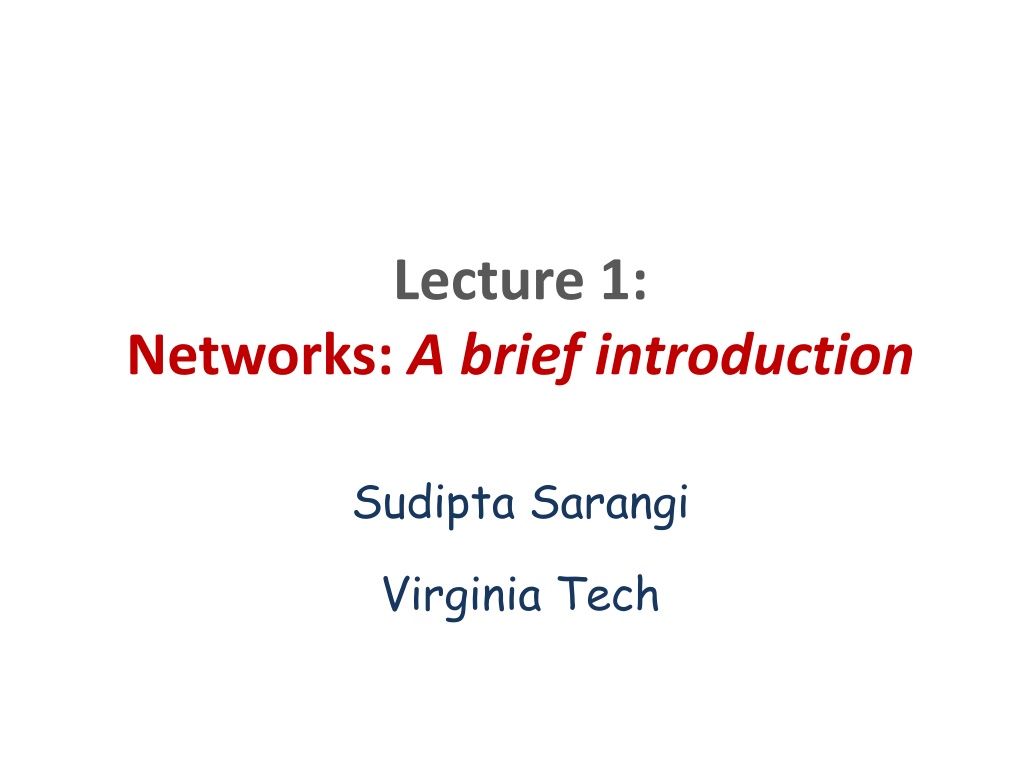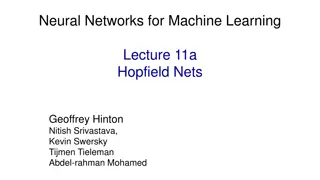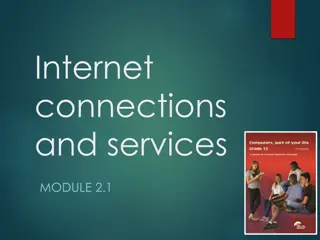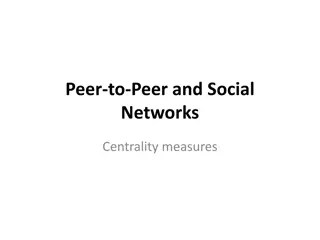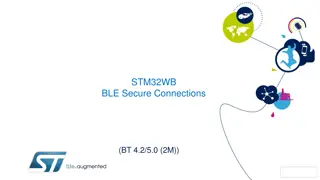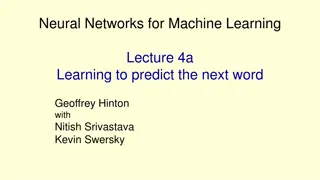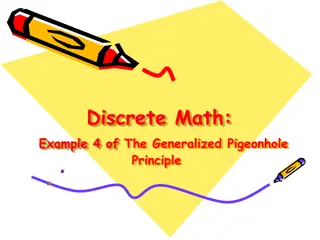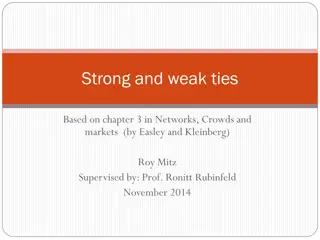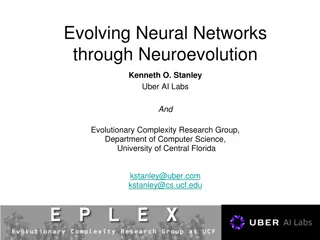Understanding Networks: An Introduction to the World of Connections
Networks define the structure of interactions between agents, portraying relationships as ties or links. Various examples such as the 9/11 terrorists network, international trade network, biological networks, and historical marriage alliances in Florence illustrate the power dynamics within different networks. Analyzing betweenness in marriage networks sheds light on the influence and connectivity of families in societal structures.
Download Presentation

Please find below an Image/Link to download the presentation.
The content on the website is provided AS IS for your information and personal use only. It may not be sold, licensed, or shared on other websites without obtaining consent from the author. Download presentation by click this link. If you encounter any issues during the download, it is possible that the publisher has removed the file from their server.
E N D
Presentation Transcript
Lecture 1: Networks: A brief introduction Sudipta Sarangi Virginia Tech
Networks Network: Defines the interaction structure between agents through the set of ties between them. Agents: individuals, organizations, countries, represented as nodes (vertices) Ties: relationships between actors, represented as links (edges) A very useful visualization tool
International Trade Network, Bhattacharya et al. (2008)
A multi-layer biological network, Institute of Biology and Technology, Saclay
Florentine marriage network around 1430s, Padgett and Ansell (1994)
Florence around 1430s and the Rise of the Medici Florence was ruled by an oligarchy of elite families: 16 families The Medici did not have wealth or political clout but used their social relationships (particularly Cosimo de Medici) to rise to power
The marriage networks tells this story The Medici had the highest number of marriage alliances: 6 Examine betweenness which measures how many paths connecting other families go through a particular family. Let P(ij) denote the number of shortest paths connecting family i to j. Let ??(ij) denote the number of these paths that family k lies on.
Florentine marriage network around 1430s, Padgett and Ansell (1994) The shortest path between the Barbadori and the Guadagni has 3 links in it: Barbadori-Medici-Albizzi-Gaudagni; Barbadori-Medici-Tournabouni-Gaudagni Extending this idea to the network and finding the average, gives us a sense of the power of a family in the network: ??(ij)/? (ij) ? 1 (? 2)/2 ??:? ?,? {?,?}
Measure of betwenness Medici: 0.522, or the Medici lie in more than half the shortest paths between the other families! Gaudagni: 0.255 (second highest) Thus to the extent that marriage relationships were key to communicating information, brokering business deals and reaching political decisions, the Medici were much better positioned than other families.
College Football Rivalry, Deck et al. (2013) PAC 10 SEC
College Football Rivalry, Deck et al. (2013) Use a clustering coefficient measure to assess which conferences present a more tightly knit rivalry network The higher the clustering coefficient, the higher is the existence of mutual and adjacent rivalries, suggesting a tightly connected conference Conferences with many strong teams have more pairwise rivalries
A Micro Measure: Centrality Centrality is a quantitative measure which aims at revealing the importance of a node. Formally, a centrality measure is a real valued function on the nodes of a graph. There are many different ways to measure it!
A Micro Measure: Centrality Degree centrality measures how connected a nodes is in the network. Who is the most connected? Who should can you talk to? Who can help you?
A Micro Measure: Centrality Closeness centrality measures how easily a node can reach other nodes in the network, or How close is someone to the others ? Who is important locally? How long will it take for information to reach from node x to the others?
A Micro Measure: Centrality Betweenness centrality measures how important a node is in terms of connecting other nodes in the network Who can be used effectively to transfer things in the network? Sudipta Sarangi to ...
How it matters? This network is hard to take down. At least 6 nodes (21%) with the most numerous and important connections will have to taken out before the network will have significant damage. Degree measures activity or how often someone contacts others Betweenness measures how often someone is a go- between or control in the network Closeness measures access or how many people can this person reach Atta scores highest on all 3 measures. Al-Shehhi comes in second because he is high on degree and closeness.
How it matters? Alhazmi comes in second in betweenness, suggesting that he exercised a lot of control, but fourth in activity and only seventh in closeness. If you eliminate the thinnest links (most recent), Alhazmi becomes the most powerful node. He is first in both control and access, and second only to Atta in activity. Hypothesis: Alhazmi played a large role in planning the attacks, and Atta came to the fore when it was time to carry them out?
A Micro Measure: Centrality Centrality measure based on neighbor s characteristics how important or connected or influential a neighbor is: Eigen vector centrality, Bonacich centrality, Katz prestige measure. Bonacich centrality: The centrality of a node is dependent on the centrality of the nodes it is connected to. How to measure Power, Influence, etc?
A Micro Measure: Centrality Inter-centrality measure (Ballester, Calvo- Armengol and Zenou (2006)) Nash equilibrium is proportional to Bonacich centrality Key player?
Studying Networks Networks are a conduit for flows. These can be: Data; Diseases; Trade; Favors; Influence; Associations Network models attempt to explain how these flows take place. Networks are inter-disciplinary: Mathematics; Sociology; Physics; Biology; Computer science; Anthropology; Operations Research and more recently Economics!
What does Economics Bring to the Table? How do these networks form? Given that relationships provide benefits but are costly, why do specific networks arise? Applying them to understand a host of phenomena exchange, jobs, favors, information, firm behavior, etc.
A brief and idiosyncratic history A brief and idiosyncratic history Euler the seven bridges of Konigsberg: (1736) Emile Durkhiem and Ferdinand Tonnies pioneered the study of social groups: late 1800s Major developments in sociology, psychology, mathematics and anthropology in 1930s
A brief and idiosyncratic history A brief and idiosyncratic history Stanley Milgram: Six Degrees of Separation Experiment; the Oracle of Kevin Bacon Mark Granovetter: The Strength of Weak Ties Structural holes Social capital: the social value of relationships Frank Harrary: Formal modeling of structural issues in networks
A brief and idiosyncratic history A brief and idiosyncratic history Erdos and Reyni: Random graphs late 1950s and 60s Specify the set of nodes N and a common probability p for link between any two nodes. This generates a random graph. Note that there is no bias towards any node. Such models became popular in SNA in the 1980s to explain degree based structural effects as well as things like reciprocity, homophily and popularity.
A brief and idiosyncratic history A brief and idiosyncratic history Watts and Strogatz: Small Worlds late 1990s Random graph model where each node is linked to its k closest neighbors and then we randomly rewire with probability p. As p gets large we get a random network. Has small world properties high clustering coefficients with small average path lengths. Examples: road maps, power grids, network of brain neurons, telephone call graphs, the networks of economists, etc.
A brief and idiosyncratic history A brief and idiosyncratic history Typically small world networks follow the power law distribution and are scale free. ? ? = ?? ?and ? ?? = ? ?? ? ? ? Some nodes for example like Google will tend to have large numbers of links coming into them, or will have a high degree distribution. Others nodes will only have a very few links. The Barabasi-Albert (1999) model of preferential attachment falls in this category
A brief and idiosyncratic history A brief and idiosyncratic history A word of caution! Ajit, Donker and Saxena: An Example 2012 Use corporate board data from the top 1000 Indian companies (in terms of assets) that are listed on the stock exchange Corporate boards are a small world or a sort of old boys network, lack diversity and are dominated by upper castes. Alternative explanation: It is an old boy s network not of caste but of (possibly the elite) institutions
Networks in Economics Issues in network formation games: What is the architecture of stable networks? What is the architecture of socially efficient networks? Do these two architectures always coincide? If not why? Can we find conditions under which they will coincide? Do stable networks always exist, especially in pure strategies? How networks affect behavior: Applications!
Networks in Economics: Approaches Cooperative game theory approach: Coalitions of players produce output and an axiomatic approach is used to define how the output will be shared. Players do not have strategies. It is assumed that coalitions can write down binding agreements. Nash networks non-cooperative approach (Bala and Goyal, 2000a,b) Pairwise Stability adds consent to links between pairs (Jackson and Wolinsky, 1996)
Non-cooperative Network Formation aka Nash networks
The beginning Bala and Goyal (2000, Econometrica) Set of n agents; N = {1, , ?, j, , n}, n 3. Play a strategic network formation game. Agents simultaneously decide who they want to link with. Strategy set: (n-1) dimensional vector ???= 1: ? intends to form a link with j ???= 0 means no such desire.
The game Agents simultaneously decide who they want to link with. Payoffs: Agent that forms links pays a fixed cost (c > 0) per link. Agent obtains information of value V > 0 from all agents she observes directly or indirectly. Agent directly observes the person they are linked with (regardless of who forms the link). Those who an agent can reach through a sequence of links are players who are indirectly observed. An agent only pays for her direct links. Indirect links are free!
Two possible models In the directed model (one-way flow), if i initiates a link with j then i observes j and not vice versa. The same is true for agents on indirect paths. In the undirected model (two-way flow), if there is a link between i and j, they both observe each other regardless of who initiates the link. The same is true for indirect links. (More general payoff functions also possible!) This will be our focus.
Stability and efficiency ??is a best response of player i if ????,? ? ??(? ?,? ?) for all ? ? ?? A network g is said to be a Nash network if ?? ???? ? for all ? ?. In a strict Nash network we replace the by >. A network g is said to be efficient if it maximizes the sum of the payoffs of all agents
Results A Nash network is either empty or minimally connected. Strict Nash is either (CS-) star or empty. Efficient network is connected. Components of efficient networks are minimal. They are hard to characterize; do not always coincide with equilibrium networks. Existence of Nash networks is an issue: Bala and Goyal show this constructively using a modified best response dynamic.
Heterogeneous values and costs Galeotti, Goyal and Kamphorst (2006) - similar results for strict Nash. Existence in pure strategies not guaranteed under cost heterogeneity. (Haller, Kamphorst and Sarangi 2007)
Imperfect links: Reliability Bala and Goyal (2000b): Allow for the possibility that a link between two agents may not work. Retain all assumptions of Bala and Goyal (2000a): Homogenous values and costs Two-way flow model + Each link only succeeds with a probability 0 < p < 1. Link failure is an independent event. The main difference is that now all paths between two agents are important!
Imperfect links: Reliability Characterization of (strict) Nash networks is partial. Key insight: Nash networks are superconnected! All three types of star networks are possible. Characterization of efficient networks is partial. Existence of Nash networks: ?? The main problem: When we add or delete a link, there is no systematic way of counting the number of new paths created.
Heterogeneous link reliability Link ij succeeds independently with probability ??? (0,1). Retain all other assumptions of Bala and Goyal (2000b). Random graphs because actual network depends on the realization. Characterization of strict Nash and efficient networks is partial. Richer set of possible networks. Non-existence of Nash networks in pure strategies.
How parameter heterogeneity matters Two possibilities: ???? or ???? What makes these two models different? In the ???? model we can eliminate a link just by making its probability very low. In the ????model a link will not disappear by making its value very low Because it might provide a path to a very valuable link! It will disappear only when ? is sufficiently low as well.
How parameter heterogeneity matters Non-existence can be shown in both models! Anything goes result! Consider the ????model with the standard payoff function. Let g be an essential network. Then there exists a link cost c > 0 a probability ? and an array V=[???] of values s.t. in the network formation game g is a strict Nash network g is an efficient network G is both a strict Nash and an efficient network.
How parameter heterogeneity matters Consider an arbitrary network g. Cannot say anything about the two models. Consider a tree. Start with equivalent networks, where ???? = ????and the cost of forming links is identical. Then: If we increase the parameter value associated with the pair ij by the same amount, the marginal benefit of a new link is negative in the first model (???? ) and positive in the second (????)!
Imperfect links: Decay Similar sorts of things. Decay creates incentives for smaller diameters and shorter paths. Stars and Core-periphery type architectures are important. Anything goes results can be found!
